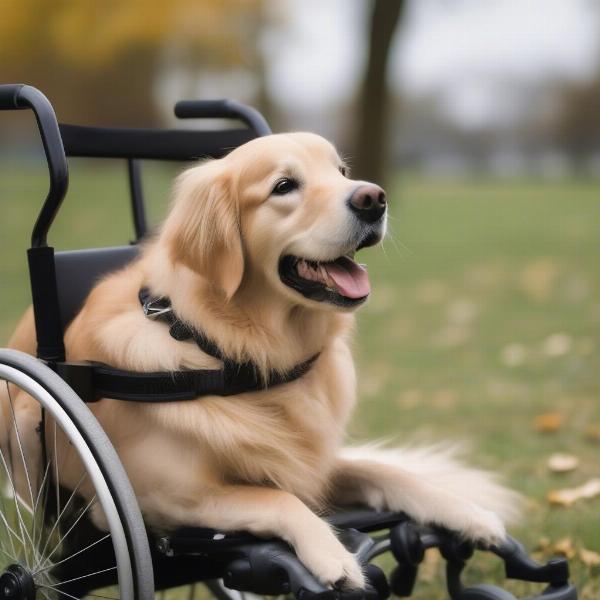Mobility issues in dogs can be heartbreaking for owners. Whether due to age, injury, or a debilitating condition, seeing your furry friend struggle to walk can be distressing. Thankfully, rear leg wheels for dogs offer a solution, providing support and restoring a sense of freedom and independence. This article will delve into the world of rear leg wheels, helping you understand the benefits, how to choose the right set, and how to help your dog adapt to this new aid.
Understanding the Need for Rear Leg Wheels
Why might a dog need rear leg wheels? Several conditions can lead to mobility impairment in a dog’s hind legs. These include arthritis, hip dysplasia, degenerative myelopathy, paralysis (partial or complete), and injuries to the spine or legs.  Dog using a rear leg wheelchair
Dog using a rear leg wheelchair
These conditions can significantly impact a dog’s quality of life, making everyday activities like walking, playing, and even going to the bathroom difficult and painful. Rear leg wheels provide the necessary support to alleviate discomfort and allow dogs to continue enjoying these activities.
Choosing the Right Rear Leg Wheels
Selecting the appropriate rear leg wheels for your dog is crucial for their comfort and well-being. Factors to consider include size, weight, and the specific condition affecting your dog.
Measuring Your Dog for Rear Leg Wheels
Accurate measurements are essential for a proper fit. You’ll need to measure the height from the ground to your dog’s lower abdomen (where the wheels will be positioned), the width of their hips, and the length from their shoulders to the base of their tail. Consult your veterinarian or a specialist in canine mobility aids for guidance on accurate measurement techniques.
Types of Rear Leg Wheels
There are various types of rear leg wheels available, each designed for different needs and conditions. Some common types include:
- Two-wheel carts: Suitable for dogs with weakness or paralysis in their hind legs.
- Four-wheel carts: Offer greater stability and support, especially for dogs with more extensive mobility limitations.
Adjusting and Fitting the Wheels
Once you’ve chosen the appropriate wheels, proper adjustment and fitting are vital. Ensure the wheels are adjusted to the correct height, allowing your dog to stand comfortably with their back level. The harness should fit snugly but not be too tight, allowing for freedom of movement. dog wheelchair for large dogs
Helping Your Dog Adjust to Rear Leg Wheels
Introducing rear leg wheels can be a significant change for your dog. Patience and positive reinforcement are crucial during this adjustment period.
Introducing the Wheels Gradually
Start by letting your dog sniff and explore the wheels. Then, gradually introduce them to the harness, rewarding them with treats and praise. Begin with short sessions, gradually increasing the duration as your dog becomes more comfortable.
Providing Support and Encouragement
Be supportive and encouraging throughout the process. Walk alongside your dog, offering reassurance and praise. Celebrate small victories and make the experience as positive as possible. used dog wheelchair for back legs
Maintaining Rear Leg Wheels
Regular maintenance is essential to ensure the longevity and functionality of the wheels. Clean the wheels and frame regularly, check for loose parts, and lubricate moving components as needed.
Benefits of Rear Leg Wheels for Dogs
Beyond the obvious benefit of restored mobility, rear leg wheels offer a multitude of advantages for dogs with limited mobility. They can help prevent muscle atrophy, improve circulation, reduce pressure sores, and promote overall physical and mental well-being. 4 wheel wheelchair for dogs
Conclusion
Rear leg wheels can be a life-changing solution for dogs struggling with mobility issues. By carefully choosing the right wheels, helping your dog adjust, and providing ongoing support, you can give your canine companion the gift of movement and a renewed zest for life. wheelchair and dog
FAQ
-
How do I know if my dog needs rear leg wheels? Consult your veterinarian if your dog is showing signs of difficulty walking, limping, or experiencing pain in their hind legs.
-
Are rear leg wheels expensive? The cost varies depending on the type and size of the wheels. wheels for dogs back legs
-
Can my dog still go to the bathroom while using rear leg wheels? Yes, most rear leg wheels are designed to allow for natural bodily functions.
-
How long does it take for a dog to adjust to rear leg wheels? The adjustment period varies, but with patience and positive reinforcement, most dogs adapt within a few days to weeks.
-
Where can I purchase rear leg wheels for my dog? Rear leg wheels can be purchased from pet supply stores, veterinary clinics, and online retailers.
ILM Dog is a leading international website dedicated to providing expert advice and resources for dog owners worldwide. We cover a wide range of topics, including dog breeds, health and medical care, training, nutrition, grooming, and product reviews. Our mission is to empower dog owners with the knowledge and tools they need to provide the best possible care for their canine companions. For expert advice on dog wheelchairs and other mobility aids, contact us at [email protected] or call us at +44 20-3965-8624. ILM Dog is here to support you and your furry friend on every step of your journey together.